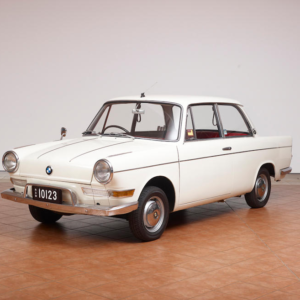
The BMW 700 was, essentially, a re-bodied BMW 600, which was a stretched and enlarged version of the BMW 300 (Isetta) which was a larger engined version of the BMW Isetta 250 which was a re-engineered ISO Isetta.
So, it is with ISO that the story of the BMW 700 must start.
The Italian company Iso AutoveicoliSpA, headed by Renzo Rivolta were best known for building refrigerators but had branched out to making motor scooters and then small three-wheeled trucks. Rivolta wanted to get into making cars. Given that Italy’s economy was, like that of Gemany, struggling to recover from second World War Rivolta decided to start by building a small economy car for mass distribution – a step up from a motor scooter. By 1952 the engineers Ermenegildo Preti and Pierluigi Raggi had designed a small car that used the engine of the medium frame Iso Moto 200 and named it Isetta—an Italian diminutive meaning little ISO.
Launched in November 1953 it was a sensation, looking like nothing that had gone before.
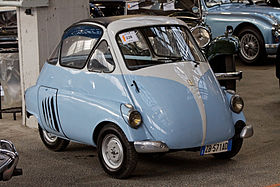
The clever design gave a super compact size with a unique and quirky front door hinged on one side, the steering wheel folding forward to allow entry and exit. Note the canvass “sun roof” which doubled as an emergency escape hatch (thus fooling the many jokes about people being trapped when parked nose in to a wall).
At just 2.29 metres long there was still (just enough) room for 4 close friends, as long as two were fairly small!
Although it looks like a 3 wheeler, there are actually 2 closely spaced (250mm apart) wheels at the back to aid stability with the engine mounted opposite the driver as a form of counterbalance (which was a problem when BMW made RHD versions with one rear wheel in England!).
With only 236 cc performance was not its main virtue, taking over 30 seconds to reach 80km/h, yet it won its class in the 1953 Mille Miglia at an average speed of 70 km/h (I guess the brakes were rarely used!).
Despite returning about 5.6 l/100 km (then a very good figure) the initial sales fell away, production problems and a higher than expected production cost caused Rivolta lost interest, wanting to concentrate on his new Iso Rivolta sports car. After about 1,000 units had been built ISO ceased production in 1955.
BMW, meanwhile, faced the same economic problems in Germany and were unable to make any money selling their upmarket luxury large saloons (the so called Baroque Angels). But as customers moved away from motorcycles as a primary mode of transport something a little better was required.
BMW had initaily approached ISO to supply them with engines, but Rivolta offered to sell them the designs and production equipment. So BMW bought the Isetta at the end of 1954.
But ISO retained the right to licence their version to others, and did so.
BMW set about re-engineering the Isetta in its own, Germanic style, making it more able to be assembled correctly, cheaper to build, more reliable, efficient and practical, utilising a 250cc motorcycle engine from their range, upping the power by over 30% without increasing fuel consumption.
Released in April 1955 the BMW Isetta sold well, and sales improved with the 1956/57 Suez crisis (Egypt blocked shipping from using the short cut Suez canal route, principally oil tankers going from the middle east to Europe, pushing up fuel prices and driving down supply).
In February 1956 changes to limits in motorcycle engine sizes imposed by the post WW2 Allies allowed BMW to up the capacity to 300 cc and make further changes, including heavily revised “Export” styling, to create the BMW Isetta 300.
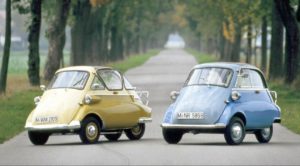
But the German economy continued to improve and Isetta sales started to falter.
The Isetta had kept BMW’s head above the water but they were no nearer the shore.
Continuing to develop the 50x range of large “Baroque Angel” saloons and sports cars (still selling slowly and not making profits) was not going to bring the sales or profits required. And there was not enough cash either on hand or to be borrowed to develop a whole new range of mid sized cars.
So the only option was to extend the Isetta 300. As this used a tubular frame chassis, pulling the rear wheels apart and stretching the wheelbase was fairly easy. A 600 cc horizontally opposed air cooled motorcycle engine and a custom 4 speed all synchromesh “transaxle” transmission was installed at the rear and an elongated version of the body, with a side door to access the enlarged rear seat space, made a recognisable big sibling to the 300.
With typical Germanic imagination this was called the BMW 600.

However a good idea this may have seemed, it was not. Sales were lacklustre, mainly because it still looked like an economy car but cost almost as much as more sophisticated alternatives such as the VW Beetle. In total only 34,000 600s were made in just over 2 years.
Of note, is that the rear suspension designed for the 600 continued to be used, in various subtle evolutions, in BMWs right up the 1990s when it was replaced by BMW’s “Z-axle design”.
But BMW’s woes continued with no solution in sight.
Something which looked like a “proper car” was needed.
BMW’s Austrian importer, Wolfgang Denzel knew this as well as anyone. Denzel ran a successful car retailing business (still exists today!) and had developed his own sports cars. In frustration at Munich coming up with a solution in 1957 he developed a prototype based on the 600 chassis and paid the Micholetti styling house to come up with stylish, modern design to fit onto it.
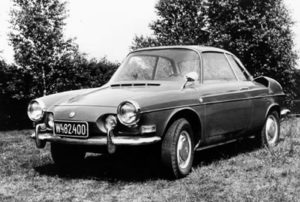
The rakish coupe design looked exactly what was needed.
In January 1958 BMW granted Denzel an official contract to develop this further and work continued in Denzel’s workshops.
The prototype coupe developed by Denzel and styled by Michelotti was presented to BMW on July 30 1958 and was very well received.
BMW’s head of design, Wilhelm Hofmeister, was tasked with converting the design into one which could be economically manufactured and yet still be appealing, toning down some of the more extravagant features of the original.
Although the coupe concept was accepted, BMW realised that buyers of an economy car would probably favour practicality over style, and a coupe would not be a big seller. So they extended the roof line to make a saloon with headroom for 4.
Willy Black, who designed the 600 chassis, did all the mechanical adaptation with von Falkenhausen uprating the R67 motorcycle engine again to 697 cc, retaining the 600’s transaxle unit. The bodywork was a unitary monocoque design, a first for BMW, dispensing with the tubular frame completely.
The 700 also retained the compact duBonnet design of front suspension borrowed from motor scooters and used to good effect in the Isetta and then the 600. This not only gave a better springing and ride characteristic than other designs but helps isolate road shock from the steering, making the ride and feel seem much more expensive than it is.
This became Project 107 and the go ahead for production tooling, financed by yet another loan, was given on 21 November 1958.
This was the BMW 700, launched to great acclaim at the August 1959 Frankfurt Motor Show (same month and year as the BMC Mini and Ford’s 105E Anglia).
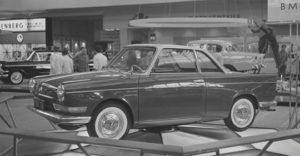
25,000 orders were quickly amassed, but all existing funds had been consumed in development and tooling. There was not enough money to buy production parts and the banks would not advance any more. The promises of a wonder car had been made before and proven false.
Because the coupe would appeal to a buyer who was less concerned about the economy car aspect of the model, BMW sold the coupe at a higher price, partially compensated for by having better equipment. This mean that the coupe had a much higher profit margin than the sedan. For this reason, the initial, restricted production in 1959 was all coupes. Only 2,648 cars were made in 1959.
BMW was now technically bankrupt and the decision to sell to Daimler-Benz, at half book price, was taken, subject to ratification by the shareholders.
That ratification was not granted at the shareholder’s meeting, thanks to delaying tactics. One of which was to question why the entire development and production costs of the 700 had been allocated to only the production so far. By amortising the costs over 2000 or so units the 700 was presented as another loss maker. Eventually the meeting was adjourned late in the evening.
Industrialist Herbert Quandt held BMW shares and he sat through the entire drawn out meeting. He was impressed by the passion for the BMW brand and, in particular, the claims made for the success of the 700. He realised that if the production and development costs were spread over a more realistic production volume it would make a profit.
He borrowed a 700 and took it to Daimler-Benz for appraisal. They thought it was a good product which could make some money.
At considerable risk to the family fortune Quandt set about buying up a controlling interest in BMW, thus preventing another shareholder’s meeting to vote on the sale resolution.
He paid off some of the debts and invested Quandt money into the production of the 700. Once production started he set about assembling a team of technical staff who knew how to design, develop and produce a quality but profitable mid size car in medium volume. Fortunately for Quandt nearby medium volume car builder Borgward were having a financial crisis of their own so there was no problem finding the right staff.
Quandt recognised the core brand values of BMW, something we now know as “sheer driving pleasure”, a value BMW had been true to until after the second world war when things went so horribly wrong.
In many ways, the 700 was the first post WW2 BMW to have those values. By enhancing those values and making them the primary design guide, the new BMW team produced the Neue Klasse cars, from which the 3, 5, 6 and 7 series sprang in the 1970’s and all other BMWs have followed.
The 700 had considerable success in motor racing and was exported to many countries, including England, Canada, and Malaya, but not Australia. It was also manufactured under licence in some countries where import restrictions prevented direct export. Amongst those was Argentina where Metalmecánica SAIC assembled the 700 sedan and sold it as a De Carlo 700 Glamor until 1964 when the same running gear was clothed with a Simca 1000 look-alike body (Metalmecánica also assembled the Simca under licence) and sold as a De Carlo SL. They also assembled some De Carlo 700 coupes in 1961.
Sources
http://www.autosdeculto.com.ar/argentinos-decarlo-700/
www.bmw700.net
The BMW Story – Horst Monnich
BMW Classic